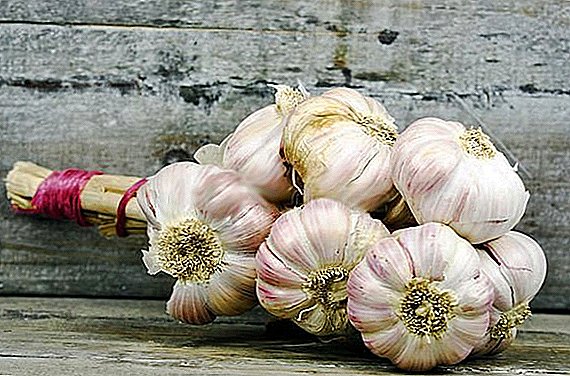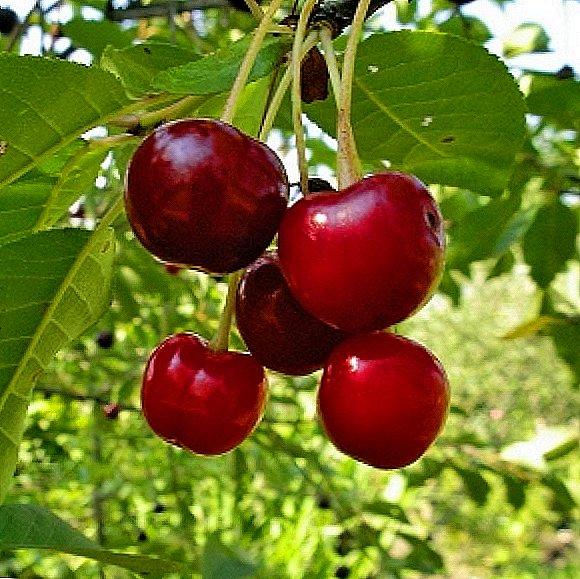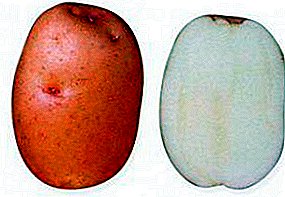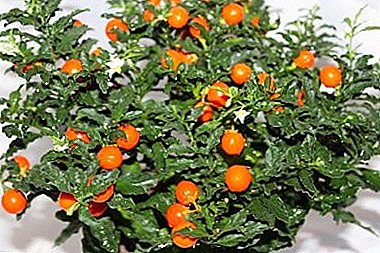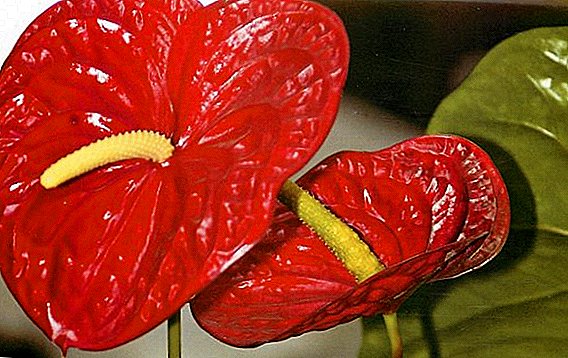 Ficuses are considered one of the most unpretentious indoor plants: they do not require either a special light regime or too frequent watering. However, even they are subject to various diseases.
Ficuses are considered one of the most unpretentious indoor plants: they do not require either a special light regime or too frequent watering. However, even they are subject to various diseases.
In this article you will learn about why Ficus turns yellow and leaves fall, what to do.
Symptoms and treatment
There are many symptoms of diseases of the plant: blackening or yellowing of the leaves, as well as their wilting, twisting and falling off, slowing the growth of the flower, nodularity or rotting of the roots, the appearance of plaque or spots on the leaves. Consider more of the disease Ficus with photos.
Blackening
Why does Ficus blacken leaves around the edges? Most likely, the reason - the wrong care for the plant.
- The problem is in the wrong solar or thermal mode.
What to do? Attention should be paid to the location of the flower: it should not be under direct sunlight and in a hot dry room.
- If a the leaves suddenly blackened and fell off, The problem lies in the wrong watering. Most likely, the soil is over-moistened, that is, you water the flower too often or too plentifully. Despite the fact that the flower loves moisture, excessive watering only hurts him.
- If they constantly turn black, despite the right care, then the problem is most likely in the composition of the soil that is not suitable for the flower.
- If sometimes getting dark but constantly wilt, the problem is in excess fertilizer. You should not feed a newly transplanted plant: a new soil contains enough substances to grow.
It is also undesirable to fertilize Ficus in winter, since an excess of minerals in the ground with a lack of sunlight and heat leads to a weakening of the plant (for more information on caring for ficus in winter, read here).
IMPORTANT! It is better to put the flower on the north window so that it receives enough light, but at the same time the rays of the sun did not injure the flower.
ATTENTION! It is recommended to water the plant twice a week and little by little, and it is possible to prevent drying by spraying the foliage with water from a spray bottle every day.
REFERENCE! The soil for ficus should be slightly acidic or neutral, most often in the pot mixed so-called "leaf soil" (sold in finished form in flower shops) with peat and humus in a ratio of 2: 1: 1, it is possible to add a small amount of sand.The diseased plant must be transplanted into a suitable soil substrate.
IMPORTANT! Excess fertilizer leads to soil salinization, which has a bad effect on the condition of the plant. It is necessary to feed Ficus once in two months with a weak solution of special fertilizer.
Yellowing
Yellow leaves - a frequent nuisance faced by the owners of Ficus.
- If yellowing is caused by the natural wilting process, then there is nothing to worry about: like all plants, the flower sheds old leaves. The fall of the lower leaves of the flower in autumn and winter is a common occurrence. As a rule, the life of the sheet - no more than two years.
- If the Ficus massively sheds leaves after you have moved the pot to a new place, then the plant is experiencing stress.
- Possible cause may be dry indoor air.
What to do? If the flower is on the window, you need to close the battery in the cold season and regularly spray the leaves.
- If this occurs after the flower has been poured, it is necessary to stop watering for a couple of weeks so that the roots of the plant do not rot. If this does happen, you should transplant the ficus into a new land and cut off rotten roots.
- Ficus are very sensitive to fluctuations in air. Pay attention to where the flower stands. If he is constantly in a draft or under the conditioner, then, most likely, his leaves will turn yellow and fall off.
- Yellowing can be caused by a lack of nutrients in the soil. In this case, help the flower is very simple: you need to feed him with any suitable fertilizer for Ficus.
IMPORTANT! The plant is very sensitive to changes in temperature, so it is not recommended to frequently move it from place to place.
What is the reason for yellowing?
ATTENTION! You should not put a ficus pot next to the door, fan or air conditioner, and also on the window if it blows from it.
REFERENCE! The main element required by the plant is nitrogen, except for it mineral fertilizers include phosphorus, potassium and calcium.
White bloom
White dots on Ficus, what is it?
Dry white dots on the plant, easily erased from the sheet, are called powdery mildew and are a fungus disease contagious to flowers. White spots appear, if the plant is in a room with stagnant air, or if fungal spores have got into the damaged leaves.
How to cure a ficus? It is possible to treat a plant with a folk remedy - wiping with a solution of household soap or with a modern one - spraying with a preparation containing copper salts.
If the white coating on the Ficus look "fluffy", then the reason for their appearance - infection of plants with mealybugs. In this case, it is necessary to thoroughly process the flower, removing plaque and pests, and then washing it out with warm water, and then sprinkle it with actelium.
ATTENTION! Solution actellica must be done in strict accordance with the instructions, and the drug itself because of its toxicity must be kept away from children and pets.
Brown spots
If the Ficus has brown spots on the leaves, then the reason should be found in excessive watering: most often such a lesion is evidence of rotting of the roots.
If brown spots appear on the leaves of the flower, it is necessary to transplant the plant as soon as possible, cutting off the rotten roots.
Large brown spots on the edges - a sign of an excess of minerals, in this case it is worth reviewing the fertilizer mode of the plant: we remind you that it is necessary to feed the flower only during the growing season (spring and summer) and with a frequency of every two months.
What if Ficus leaves fall?
There are several possible reasons why Ficus leaves leaves:
- Wrong watering. The optimal mode of watering the plant - twice a week.
- Stress plants due to its rearrangement.
What to do in this case? It is recommended to allocate a permanent place for the flower and to rearrange it as rarely as possible. Also it is impossible to allow sudden changes in temperature and humidity. Do not put a flower in a draft. - Low humidity. To eliminate it, you need to regularly spray the plant from the spray.
- Excess fertilizer. Do not abuse fertilizers, too frequent dressing leads to soil salinization and plant death.
- Why do the leaves fall off at Ficus?
Improper soil composition. You should buy a special ground for ficuses or independently make a soil mixture (the ground is mixed with sand, peat, humus, expanded clay is added for loosening).
If Ficus shed leaves in autumn and winter - absolutely normal and natural phenomenon, it is worth worrying only if they are showered during the growing season, that is, in spring and summer.
Let us consider in more detail what to do in the video below:
Effect of temperature on the plant
 The ficus should not be too dry in a hot room, or supercool. What to do if the flower still suffered from a temperature violation?
The ficus should not be too dry in a hot room, or supercool. What to do if the flower still suffered from a temperature violation?
- If the plant is frozen, it is necessary to remove it from the draft (if it is standing on a blown window or under the conditioner) and to ensure a constant temperature of about 20 degrees.
Frozen flower should be sprinkled with settled water at room temperature and not watered until new shoots appear. After the plant comes to life, you can water it and fertilize it as usual.
- If the plant is standing in a hot room with insufficient air humidity, then the tips of the leaves of the Ficus dry, and they also begin to dry, twist and fly around, shoots may fall off.
If the flower is over dry, water it with settled water at room temperature, move it away from the battery and spray it with water every day.
Has the flower slowed down or stopped growing?
The reason should be sought in the wrong care (incorrect solar and temperature conditions, excessive watering, lack of feed). Eliminating the problem of care will bring your Ficus back to life. For prevention it is necessary Replant the plant every 1-2 years in a larger pot.
REFERENCE! It is possible to transplant indoor plants only during the growing season, it is best in the spring, so that the roots grow well in a new pot.
Pests
Insect pests cause many plant diseases. The following are the main pests and ways to combat them:
- Shchitovka. This pest sucks the juice from the plants, which leads to a slower growth of the appearance of brown spots on the leaves, mainly on the inside. The shield leaves a sticky plaque that becomes a favorable environment for the development of black fungi.
How to save a ficus?
You need to fight with the shield as follows: we dip our hands in a soap solution and clean the leaves of sticky plaque, and then for three weeks we treat the ficus with an actellic solution.Next on the photo is presented the shield on Ficus:
- Spider mite It can be of two types: red and yellow. However, the damage they cause is the same - the tick on the Ficus bites into the leaves and sucks the juice out of them. On the leaves, he leaves gray with a brown tinge bloom. If you find a spider web on a flower, this indicates its infection with a spider mite.
Look further at the photo spider mite on Ficus:
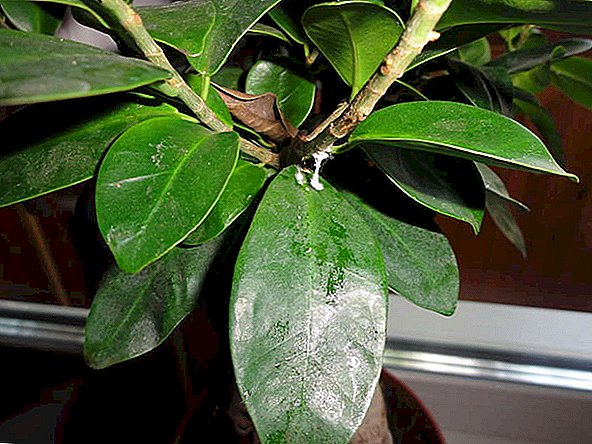
ATTENTION! Spider mite is very contagious and multiplies rapidly. To get rid of it, you need to provide high humidity and spray the leaves with settled water at room temperature, mixed with soapy water, and cover the plant with plastic wrap for several days.
How to treat ficus?
There is a popular method of dealing with spider mites - spray flower infusion of garlic. - Aphid. Determining the defeat of a leaf by aphids is easy: they lose color and curl because aphids feed on their juice.
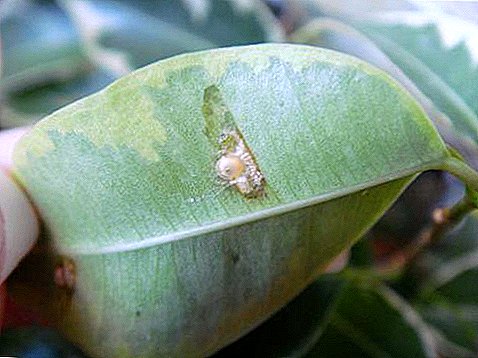
REFERENCE! Active during the growing season of plants (spring and summer), dangerous because it quickly flies to other plants.
You can find aphid colonies on the back of the leaves. It's easy to remove aphids; you don't even need chemicals to do this; this is done with soapy water (10 g of soap per 1 liter of water).
Popular methods of struggle - spraying a decoction of onion, wormwood or dandelion husks.
- Midges. They appear in winter from excess moisture and harm the root system of the flower.
What to do, if in a ficus midges were got?
To get rid of them, you need transplant a flower into a new land and be sure to clean the roots, and then process the flower with a special chemical solution from the midges.

You can learn more about how to save a flower from Shchitovka on the video below:
Proper care and timely prevention is the key to the health of your flower. Observe the temperature and light conditions, watering on time, spray and fertilize the plant, repot it regularly, clean the pot tray and choose the right place for it.




